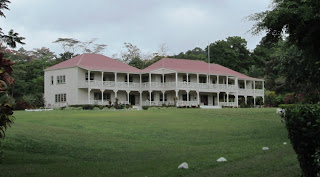It was once again time to continue our westward track so we broke the bonds of Bora Bora at 14:00 on August 30th - the last island/atoll of the French Polynesia Archipelago for us. We had wanted to stop at 1 more - Maupiti - but the wind was blowing too strong for a safe entry.
The strong winds whipped up a confused sea and the motion was very rolly. As the sun sank and night overtook us, we had 1 young, tired, yellow-footed boobie bird spend the night on the dinghy davits at the rear of our solar panel with its beak perilously close to our spinning wind generator. The concern was not only for our visitor's well being but if he was to make contact with the spinning blades, it would be sure to damage them, making the generator non-functional.
Our wind generator has been a valuable supplemental charging unit, to the extent that we rarely have to use the motor's generator. It was amazing to see how our avian visitor was able to perch and even sleep with its head tucked back under its feathers while the boat pitched and yawed in the turbulent seas. Jordan went out and reached under the solar panel and poked the young bird who immediately withdrew his buried head and gawked around dumbfounded. It was evident that he was there to stay for the night.
Our destination is the remote atoll of Suwarrow which is 1 of the northern Cook Islands. Among many boaters, it was a great debate whether to take this more northerly route or the more southerly one, weather being the great decider.
A few boaters leaving Bora Bora around the same time as us headed towards the south islands of Rarotonga and Palmerston, etc. but soon changed course for Suwarrow as they were bashing into heavy headwinds. We had originally wanted to go south but after checking grib files, we chose the more northern Suwarrow route, and even then, we got a bit of a whomping. We checked into the HAM net daily, giving our position and progress, and listened to the other boats enroute who all complained about the sea state.
It's always a joy though to be out to sea again. To enjoy the solitude of just me and my favourite Captain under a full moon. To witness the shades of the differing blues of the open ocean - this time a deep purple blue. To revel in the total silence from city life. To feel free!
The six degrees of freedom are what naval architects call the six different motions that a floating vessel makes: Rolling, Pitching, Yawing, Heaving, Swaying, Surging.
The above quote is from a great book,
Moby-Duck, by Donovan Hohn. (Yes, Moby-Duck, not Moby Dick.) I think we felt all 6 on this rough 6-day passage!
After dropping anchor (S13°14.962' W163°06.724') at 10:00 in the protected waters of Suwarrow's lagoon, we both let out a breath of relief and relaxed briefly to the gentle sway of the calm waters with 29 other boats nearby!
Suwarrow was indeed a great choice. The Cook Islands are now self-governing and has been declared a National Park. There are only 2 residents - 2 Park Rangers - for 6 months each year. (The Park closes down in November each year.)
Suwarrow is a very peaceful and beautiful with clear blue waters and the best visibility we have found yet. It is a typical atoll, comprised of mostly lagoon, ringed and protected by coral reefs with waves breaking over interspersed very low-lying motus covered with mostly coconut palms.
These atolls are a danger to the nocturnal mariner as they are barely visible in the blackness of night. As one approaches, there is a heightened awareness and uneasiness. But the attentive sailor is usually rewarded with the sight of shimmering foam and the roaring of the breakers that makes the reef outline discernible. This atoll was originally called Suvorov after a Russian general who claimed to the first to discover it years ago. Of course the native Polynesians beg to differ and they are sure to tell you that now it is called Suwarrow, the preferred name by these ancestral people.
(This place is known by several other names also:
aka Suvarov, Suvarou, and with many other spellings of Suwarrow.)
Once ashore, we completed the check-in procedures with hospitable Harry, a Polynesian native of Cook Islands and 1 of the 2 Park Rangers, for a cost of $50 per boat. It's so nice to once again be back in areas where English is considered a main language!
Tied up at the dinghy dock
Park's amenity (swing hanging from tree)
Where to next?
The assistant Park Ranger, Antony (nicknamed Ants) was escorting about 10 cruisers in the Park's panga to another motu 4.5 to 5 km (7 to 8 miles) away for snorkelling, bird watching, and coconut crab collecting. This is something that Ants is amenable to doing if the cruisers congregate themselves and provide fuel for the panga as there is NO fuel available here.
Harry and Antony both love their paradise reclusive jobs at idyllic Suwarrow even though they have to leave their families behind for 6 months each year - Antony has 8 children and 8 grandchildren! Both intend to return next year...
Harry's and Antony's kitchen



































